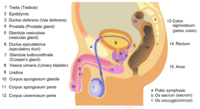
Photo from wikipedia
Background To investigate the experience of the use of seminal vesicleendoscope in the treatment of hemospermia and ejaculatory duct obstructive azoospermia. Methods The clinical data of 87 patients between February… Click to show full abstract
Background To investigate the experience of the use of seminal vesicleendoscope in the treatment of hemospermia and ejaculatory duct obstructive azoospermia. Methods The clinical data of 87 patients between February 2015–May 2018 with hemospermia and 6 patients with obstructive azoospermia were analyzed retrospectively. The characteristics of such patients in diagnosis, treatment and prognosis were discussed. Results All the 93 patients underwent MRI before operation. Among 87 patients with hemospermia, MRI showed that the unilateral or bilateral seminal vesicle expansion accounted for 57.5% (50/87), and signal abnormality of unilateral or bilateral seminal vesicle was 77.0% (67/87), the seminal vesicle dilatation combined with abnormal signal in the seminal vesicle was 51.7% (45/87). For the 6 patients with azoospermia, 5 patients showed bilateral seminal vesicle dilatation, and 4 of them showed abnormal signals in the seminal vesicle. Eighty-five patients with hemospermia (97.7%) and 5 of the 6 patients with azoospermia successfully explored the seminal vesicles. Patients with hemospermia did not suffer recurrence after follow-up of 3 months to 3 years. Sperm could be seen in the semen after 3 months’ follow-up for the 5 patients with azoospermia. Conclusions MRI has obvious advantages in the diagnosis of seminal vesicle disease. The seminal vesicle endoscope can treat hemospermia and ejaculatory duct obstructive azoospermia effectively.
Journal Title: Translational Andrology and Urology
Year Published: 2018
Link to full text (if available)
Share on Social Media: Sign Up to like & get
recommendations!